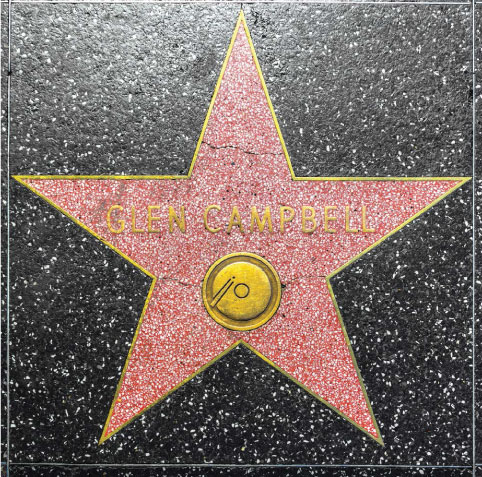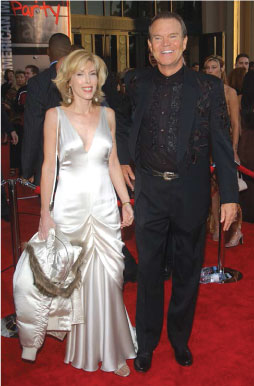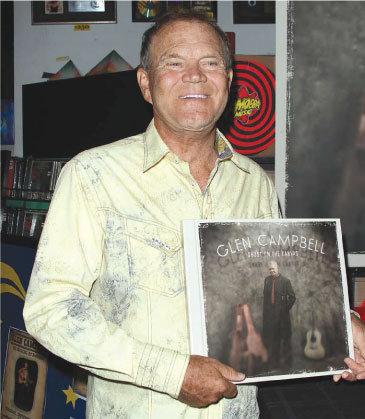 It’s not often a celebrity has a career that spans more than 50 years. It’s also uncommon for a person affected by Alzheimer’s disease to release a record that makes it in the top 10 on the Billboard chart. Meet Glen Campbell. Throughout the years, the 8-time Grammy Award-winning country music superstar has put out such hits as “Rhinestone Cowboy,” “Gentle on My Mind” and “Wichita Lineman.”
It’s not often a celebrity has a career that spans more than 50 years. It’s also uncommon for a person affected by Alzheimer’s disease to release a record that makes it in the top 10 on the Billboard chart. Meet Glen Campbell. Throughout the years, the 8-time Grammy Award-winning country music superstar has put out such hits as “Rhinestone Cowboy,” “Gentle on My Mind” and “Wichita Lineman.”
In 2011, Campbell revealed doctors had diagnosed him with Alzheimer’s, and he would be releasing his final album and embarking on one last tour, dubbed “The Glen Campbell Goodbye Tour.” Now, two years later, despite the progression of the disease, the 77-year-old hitmaker recently released another album, See You There, and he and his family have been busy in the fight for Alzheimer’s research.
Early Life

Although he’s really from Billstown, Arkansas, Campbell has always said he’s from Delight, Arkansas, because Billstown is so small he’s never seen it on a map. Born on April 22, 1936, to sharecroppers, Campbell was one of 10 children. He developed a love for music at an early age—first, by listening to the congregation sing at church, and then by a battery-operated radio. When he heard about a black church a few miles away—one where the members sang fast music with heavy rhythms—he had to see it. He would hike to the church, stand just below the window, rise on his bare tiptoes and peek inside at the people, who were caught up in the spirit and the music. “It was my first experience of seeing how moving music could be to people,” he recalled in his autobiography, Rhinestone Cowboy. “I had never seen so much unleashed passion and I hungered to be around the rhythm and music that I felt as much as heard …,” he wrote.
His dad bought him a $5 guitar when he was four. From the moment he got it out of the mailbox, he couldn’t keep the guitar out of his hands. By time he was eight, Campbell and an uncle—who he says was the best guitar player in the family—formed a band and played in schoolhouses, at church functions, and on local radio shows. When Campbell was 15, the pair hit the road and played at bars and nightclubs. Campbell didn’t know it at the time, but he was on his way.
Makings of a Star
Eventually Campbell landed in Albuquerque, New Mexico, and started his own band, The Western Wranglers. At age 17, he married his pregnant girlfriend, Diane. They lost their first child, but later had another. The couple divorced after six years. Later that year, he remarried (he and his second wife went on to have three children), and he and his new bride headed to Los Angeles in hopes he would make it in the major leagues.
After a rocky start (he was stiffed for payment several times), he landed a job writing songs and recording demos for a song publishing company. There he met Jimmy Bowen, another staff writer, who would go on to produce Frank Sinatra, George Strait, Reba McEntire, and many others, including Campbell. Through the friendship and association with Bowen, who had become a producer for Capitol Records, Campbell got into session work—providing backup instrumentals or vocals for artists. He couldn’t read sheet music, but he was allowed to play by ear because of his talent.
He became part of a group of L.A. studio musicians that later came to be known as “the Wrecking Crew,” given that name by drummer and head member Hal Blaine, because older session musicians thought this younger, more informal group, in their jeans and T-shirts, was wrecking the business. The crew was in high demand because they had a reputation for being able to knock out a stellar record in little time. Campbell, who had grown up so poor the family sometimes didn’t have food, was making a six-figure income. And the Wrecking Crew backed what seems like a who’s who of the top music stars of that time: Elvis, Frank Sinatra, Dean Martin, The Beach Boys, Nat King Cole, Simon & Garfunkel, and many others. “I was floating on cloud nine,” said Campbell in a 2011 USA TODAY interview. “To play with that caliber of musicians, it really opened my eyes and made my playing better.”
Flying Solo
Campbell continued working with the Wrecking Crew while attempting to launch a solo singing career. Throughout the years, he put out quite a few singles—some successful, others not so much. In 1964, he filled in on tour with The Beach Boys when lead vocalist and bassist Brian Wilson got ill.
It wasn’t until 1967, though, that Campbell had his first big hit. With “Gentle on My Mind,” penned by John Hartford, Campbell’s solo career took off overnight. In a little over a year, he had a string of additional hits: “By the Time I Get to Phoenix,” “Dreams of the Everyday Housewife,” “Galveston,” “I Wanna Live,” and “Wichita Lineman,” all of which took top spots on the charts. By the end of 1968, Campbell had five Grammy Awards and Country Music Association (CMA) awards for Male Vocalist of the Year and Entertainer of the Year.
Already a household name, Campbell cinched his spot when he entered the world of television. After a summer hosting gig on The Smothers Brothers Comedy Hour, he was offered his own show. The Glen Campbell Goodtime Hour, a variety show, aired on CBS from 1969 through 1972 and was nominated for Golden Globes and Emmys. Campbell co-starred with John Wayne in the movie True Grit in 1969. For his role, he was nominated for a Golden Globe, and the title song, which he sang, received a nomination for an Academy Award. Campbell also appeared in Norwood, Any Which Way You Can, and Rock-a-Doodle.
Campbell released his biggest hit in 1975. “Rhinestone Cowboy,” the title track of his 30th studio album, was a smash hit with country and pop audiences. It snagged number one spots on Billboard’s Hot 100, Adult Contemporary, and Country Singles charts. However, things weren’t going as great in his personal life. After 16 years of marriage, he and his second wife divorced. Soon after, he remarried, and he and his third wife had one child.
Through the years, Campbell still performed and released music, despite alcohol and drug addiction. In 1981, once-again divorced, he went on a blind date with a Radio City Music Hall dancer. He and Kimberly Woolen married and have three children together. In all, Campbell has eight children: Debby, Kelli, Travis, Kane, Dillon, Cal, Shannon, and Ashley.
With rehab and the support of his wife, Kim, Campbell conquered his addictions. In the ’90s he released several gospel albums. He was inducted into the Country Music Hall of Fame in 2005.
Here and Now
After the revelation of his Alzheimer’s diagnosis, Campbell experienced a resurgence of popularity. Ghost on the Canvas, released in June 2011 and intended to be his last album, peaked at number six on the Billboard Country chart. Campbell was top cowboy again when some of today’s biggest country stars—Keith Urban, Vince Gill, and Brad Paisley— sang his songs during a tribute at the 45th CMA Awards.
Assisted by a teleprompter and his band, which includes his three children with Kim—sons Shannon on guitar, Cal on drums, and daughter Ashley played banjo and keyboard—Campbell hit the road in August 2011 for his farewell tour. Once again, he made magic. Although he did have memory lapses and visible disorientation on stage at times, his kids were able to help him through it, and fans eagerly filled
in when he forgot lyrics.
At the 2012 Grammy Awards, Campbell performed
“Rhinestone Cowboy” to a standing ovation, and he received a Lifetime Achievement Award. A few months later, Campbell’s health forced the family to cancel the Australian and New Zealand leg of the tour.
Campbell’s battle with Alzheimer’s has progressed to a point where he can no longer do interviews or perform. In a recent Country Weekly interview, his wife Kim, who he’s been married to for 31 years, says Campbell now has trouble speaking and can’t be left alone for even the shortest amount of time.

During the tour, many of Campbell’s appearances were benefit concerts with proceeds going to Alzheimer’s research. His family continues where he left off by speaking up about the disease that has stolen his lyrics and memories. Earlier this year, Ashley (with her mom and dad by her side) testified at a Senate hearing in Washington, D.C., for more funding for Alzheimer’s research. Speaking about why her dad chose to tour after his diagnosis, Ashley said, “For my dad and my family, talking about his diagnosis publicly was important. It is important for people to know that individuals with Alzheimer’s can keep doing what they love—that life doesn’t end right away when you are diagnosed with Alzheimer’s,” she said. “It was also so important for my dad to take action and help spread the word about the need to find a cure.”
Of his struggles, the family is managing as best as it can. “I just go day to day and try to keep him happy and healthy,” Kim said. As for Campbell himself, the Rhinestone Cowboy is thankful and seems to have made his peace with the condition. In an interview last year, he said, “I’ve accomplished everything I wanted to do. I’ve been blessed. When I think back to where I came from, I have been able to do some amazing things in my life.”










